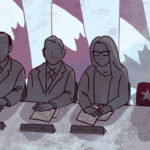Montreal’s Pride Parade returned with vibrant energy yesterday, filling downtown streets with celebration while also sending powerful political messages about ongoing LGBTQ+ rights struggles.
The annual event, marking its 18th official year, drew thousands of participants despite early morning rain that eventually gave way to sunshine just as the procession began. This timing wasn’t lost on longtime attendee Marie Duchesne, who told me, “The clouds parting right as we started marching—it felt symbolic, non? Like hope breaking through difficulty.”
This year’s parade route along René-Lévesque Boulevard featured over 120 contingents representing community organizations, corporate sponsors, and political parties. The atmosphere balanced jubilation with activism, reflecting Pride’s dual identity as both celebration and protest.
“We’re here to party, yes, but also to remind everyone that our rights remain under threat,” explained Jean-François Perrier, executive director of LGBTQ+ advocacy group Ensemble Montréal. “The rising incidents of hate crimes targeting our community in Quebec this past year means we can’t separate the festivity from the fight.”
Statistics from Montreal police confirm Perrier’s concerns, with reported hate incidents against LGBTQ+ individuals increasing 12% over the previous year. This reality gave special significance to this year’s theme: “Solidarity Without Borders.”
The international dimension was prominently featured, with several contingents highlighting global struggles for LGBTQ+ rights. Particularly moving was a group of Ukrainian LGBTQ+ refugees who marched with signs connecting their experiences to the broader human rights struggle.
Premier François Legault made an appearance, though his reception was noticeably mixed—a reflection of ongoing tensions between the provincial government and LGBTQ+ advocates over certain policies affecting trans youth. When asked about this response, Legault emphasized his government’s commitment to equality while acknowledging “ongoing dialogue is necessary.”
Mayor Valérie Plante received considerably warmer cheers while dancing alongside drag performers at the front of the parade. “Montreal stands firmly as a sanctuary city for all LGBTQ+ people,” Plante declared to the crowd. “Our diversity isn’t just something we tolerate—it’s what makes us strongest.”
The technical execution of this year’s parade showed marked improvements following criticisms from previous years. Organizers had clearly taken accessibility concerns seriously, with designated viewing areas for people with mobility issues and ASL interpreters stationed throughout the route.
As someone who has covered this event for over a decade, I noticed subtle but significant changes in the crowd demographics. Families with young children were more numerous than ever before, suggesting the mainstreaming of Pride continues to evolve. Seven-year-old Léo, attending with his two mothers, summarized his experience simply: “It’s the best day because everyone is happy and there’s candy.”
The corporate presence remained substantial, with major banks and tech companies fielding large contingents. This commercial aspect of Pride continues to generate debate within the community, with some questioning whether the event has strayed from its radical roots.
“We need these sponsors to fund everything, c’est sûr,” acknowledged volunteer coordinator Samantha Tremblay. “But we’re always asking ourselves how to balance that support with maintaining our authenticity and purpose.”
The parade culminated in an emotional moment when the “Chosen Family” contingent—representing LGBTQ+ elders and youth marching together—received a standing ovation from spectators. Many of these elders had lived through periods of criminalization and discrimination, their presence serving as a powerful reminder of historical struggles.
“I couldn’t have imagined this when I was young,” said 72-year-old Roland Bélanger, wiping away tears. “To see all these people, all these young ones living freely—c’est un miracle.”
The celebration continues throughout the week with panel discussions, performances, and community events across the city. While yesterday’s parade represents the most visible aspect of Pride, organizers emphasize that the work of building acceptance and fighting discrimination continues year-round.
As the final floats passed and street cleaners began their work, the parade’s ephemeral nature highlighted both how far Montreal has come and how vigilant the community remains. Pride here isn’t just a colorful spectacle—it’s a constantly evolving conversation about identity, belonging, and the ongoing pursuit of genuine equality.
In the words of drag performer and parade co-host Mona DéSoire, who offered perhaps the day’s most apt summary: “Pride is both our history and our future. We celebrate today while remembering yesterday and demanding better for tomorrow.”







